Influence of Culture, Power, and Politics on Individual and Group Behavior
VerifiedAdded on 2023/01/19
|11
|3694
|57
AI Summary
This document explores the influence of culture, power, and politics on individual and group behavior in an organization. It discusses the impact of organizational culture on team behavior, content and process theories of motivation, ways to influence staff behavior, differences between effective and ineffective teams, theories of team development, and concepts and ways of thinking in organizational behavior.
Contribute Materials
Your contribution can guide someone’s learning journey. Share your
documents today.
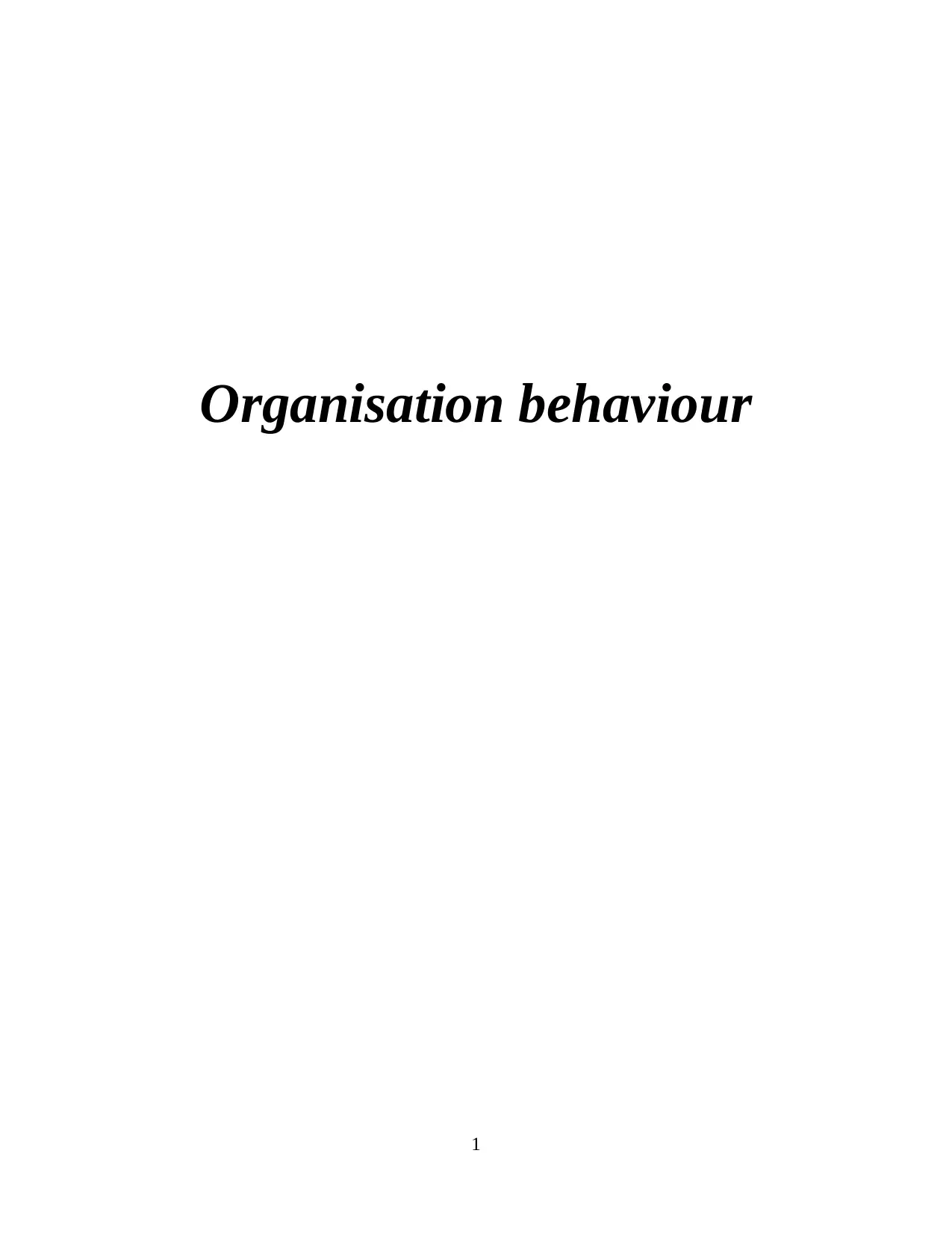
Organisation behaviour
1
1
Secure Best Marks with AI Grader
Need help grading? Try our AI Grader for instant feedback on your assignments.
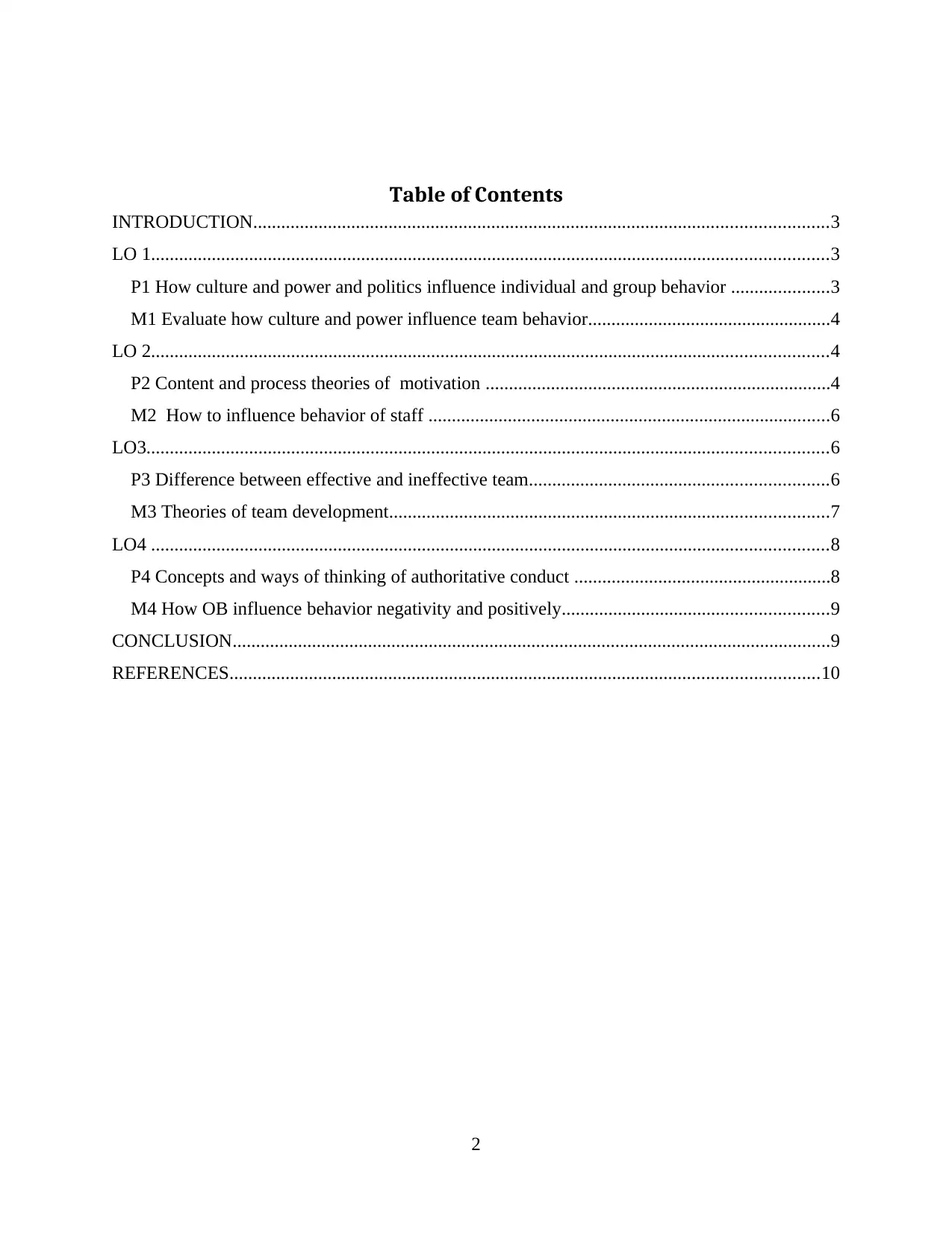
Table of Contents
INTRODUCTION...........................................................................................................................3
LO 1.................................................................................................................................................3
P1 How culture and power and politics influence individual and group behavior .....................3
M1 Evaluate how culture and power influence team behavior....................................................4
LO 2.................................................................................................................................................4
P2 Content and process theories of motivation ..........................................................................4
M2 How to influence behavior of staff ......................................................................................6
LO3..................................................................................................................................................6
P3 Difference between effective and ineffective team................................................................6
M3 Theories of team development..............................................................................................7
LO4 .................................................................................................................................................8
P4 Concepts and ways of thinking of authoritative conduct .......................................................8
M4 How OB influence behavior negativity and positively.........................................................9
CONCLUSION................................................................................................................................9
REFERENCES..............................................................................................................................10
2
INTRODUCTION...........................................................................................................................3
LO 1.................................................................................................................................................3
P1 How culture and power and politics influence individual and group behavior .....................3
M1 Evaluate how culture and power influence team behavior....................................................4
LO 2.................................................................................................................................................4
P2 Content and process theories of motivation ..........................................................................4
M2 How to influence behavior of staff ......................................................................................6
LO3..................................................................................................................................................6
P3 Difference between effective and ineffective team................................................................6
M3 Theories of team development..............................................................................................7
LO4 .................................................................................................................................................8
P4 Concepts and ways of thinking of authoritative conduct .......................................................8
M4 How OB influence behavior negativity and positively.........................................................9
CONCLUSION................................................................................................................................9
REFERENCES..............................................................................................................................10
2
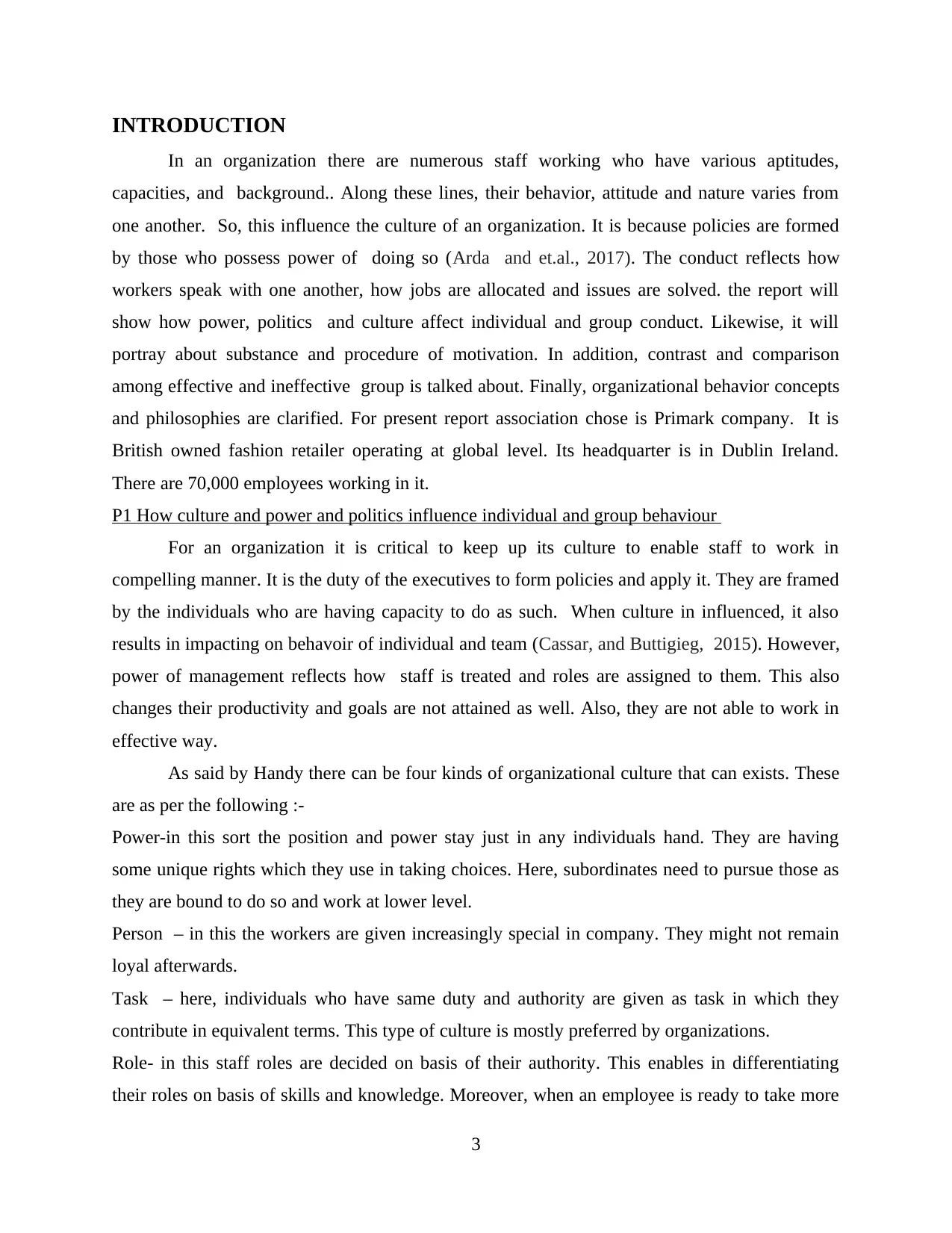
INTRODUCTION
In an organization there are numerous staff working who have various aptitudes,
capacities, and background.. Along these lines, their behavior, attitude and nature varies from
one another. So, this influence the culture of an organization. It is because policies are formed
by those who possess power of doing so (Arda and et.al., 2017). The conduct reflects how
workers speak with one another, how jobs are allocated and issues are solved. the report will
show how power, politics and culture affect individual and group conduct. Likewise, it will
portray about substance and procedure of motivation. In addition, contrast and comparison
among effective and ineffective group is talked about. Finally, organizational behavior concepts
and philosophies are clarified. For present report association chose is Primark company. It is
British owned fashion retailer operating at global level. Its headquarter is in Dublin Ireland.
There are 70,000 employees working in it.
P1 How culture and power and politics influence individual and group behaviour
For an organization it is critical to keep up its culture to enable staff to work in
compelling manner. It is the duty of the executives to form policies and apply it. They are framed
by the individuals who are having capacity to do as such. When culture in influenced, it also
results in impacting on behavoir of individual and team (Cassar, and Buttigieg, 2015). However,
power of management reflects how staff is treated and roles are assigned to them. This also
changes their productivity and goals are not attained as well. Also, they are not able to work in
effective way.
As said by Handy there can be four kinds of organizational culture that can exists. These
are as per the following :-
Power-in this sort the position and power stay just in any individuals hand. They are having
some unique rights which they use in taking choices. Here, subordinates need to pursue those as
they are bound to do so and work at lower level.
Person – in this the workers are given increasingly special in company. They might not remain
loyal afterwards.
Task – here, individuals who have same duty and authority are given as task in which they
contribute in equivalent terms. This type of culture is mostly preferred by organizations.
Role- in this staff roles are decided on basis of their authority. This enables in differentiating
their roles on basis of skills and knowledge. Moreover, when an employee is ready to take more
3
In an organization there are numerous staff working who have various aptitudes,
capacities, and background.. Along these lines, their behavior, attitude and nature varies from
one another. So, this influence the culture of an organization. It is because policies are formed
by those who possess power of doing so (Arda and et.al., 2017). The conduct reflects how
workers speak with one another, how jobs are allocated and issues are solved. the report will
show how power, politics and culture affect individual and group conduct. Likewise, it will
portray about substance and procedure of motivation. In addition, contrast and comparison
among effective and ineffective group is talked about. Finally, organizational behavior concepts
and philosophies are clarified. For present report association chose is Primark company. It is
British owned fashion retailer operating at global level. Its headquarter is in Dublin Ireland.
There are 70,000 employees working in it.
P1 How culture and power and politics influence individual and group behaviour
For an organization it is critical to keep up its culture to enable staff to work in
compelling manner. It is the duty of the executives to form policies and apply it. They are framed
by the individuals who are having capacity to do as such. When culture in influenced, it also
results in impacting on behavoir of individual and team (Cassar, and Buttigieg, 2015). However,
power of management reflects how staff is treated and roles are assigned to them. This also
changes their productivity and goals are not attained as well. Also, they are not able to work in
effective way.
As said by Handy there can be four kinds of organizational culture that can exists. These
are as per the following :-
Power-in this sort the position and power stay just in any individuals hand. They are having
some unique rights which they use in taking choices. Here, subordinates need to pursue those as
they are bound to do so and work at lower level.
Person – in this the workers are given increasingly special in company. They might not remain
loyal afterwards.
Task – here, individuals who have same duty and authority are given as task in which they
contribute in equivalent terms. This type of culture is mostly preferred by organizations.
Role- in this staff roles are decided on basis of their authority. This enables in differentiating
their roles on basis of skills and knowledge. Moreover, when an employee is ready to take more
3
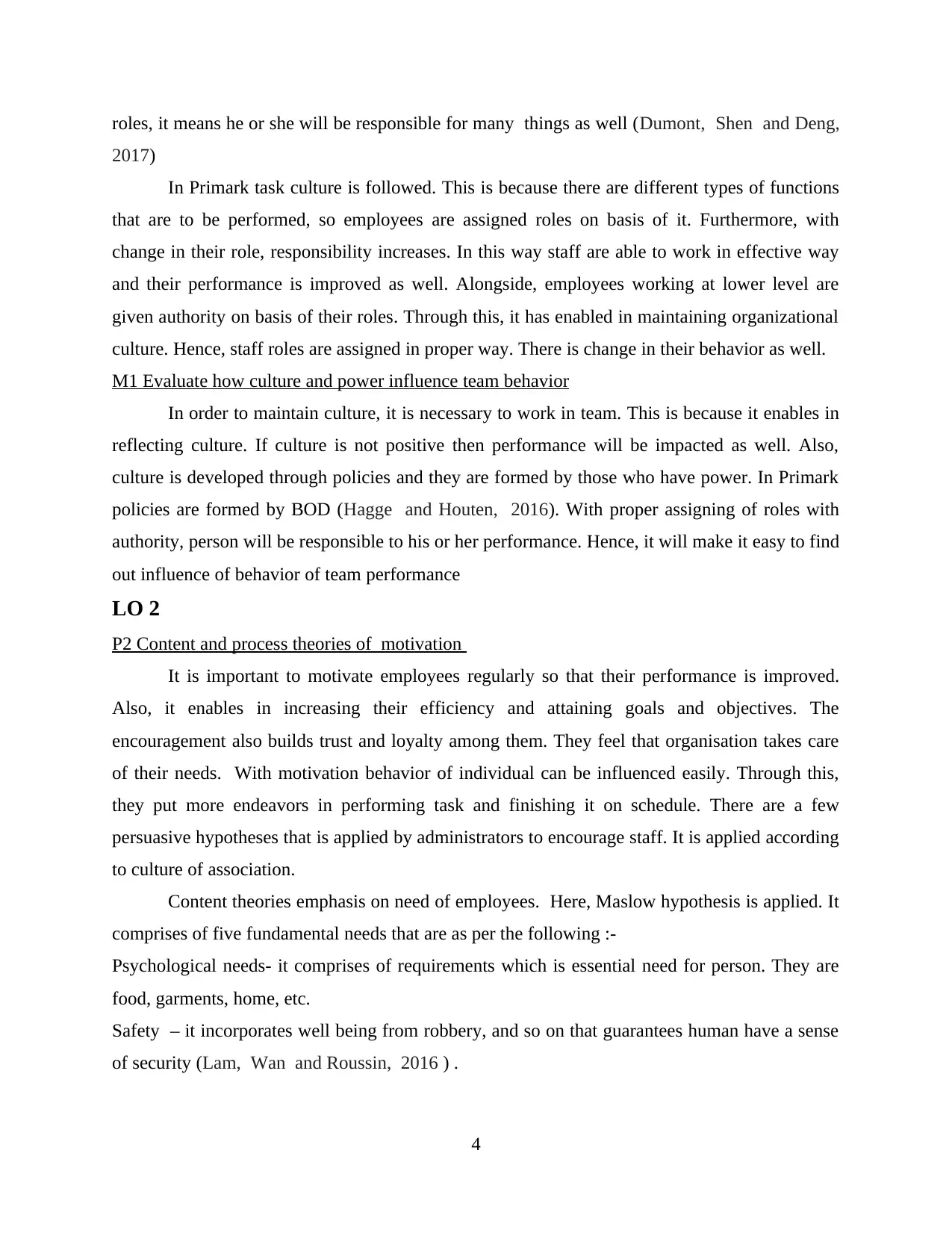
roles, it means he or she will be responsible for many things as well (Dumont, Shen and Deng,
2017)
In Primark task culture is followed. This is because there are different types of functions
that are to be performed, so employees are assigned roles on basis of it. Furthermore, with
change in their role, responsibility increases. In this way staff are able to work in effective way
and their performance is improved as well. Alongside, employees working at lower level are
given authority on basis of their roles. Through this, it has enabled in maintaining organizational
culture. Hence, staff roles are assigned in proper way. There is change in their behavior as well.
M1 Evaluate how culture and power influence team behavior
In order to maintain culture, it is necessary to work in team. This is because it enables in
reflecting culture. If culture is not positive then performance will be impacted as well. Also,
culture is developed through policies and they are formed by those who have power. In Primark
policies are formed by BOD (Hagge and Houten, 2016). With proper assigning of roles with
authority, person will be responsible to his or her performance. Hence, it will make it easy to find
out influence of behavior of team performance
LO 2
P2 Content and process theories of motivation
It is important to motivate employees regularly so that their performance is improved.
Also, it enables in increasing their efficiency and attaining goals and objectives. The
encouragement also builds trust and loyalty among them. They feel that organisation takes care
of their needs. With motivation behavior of individual can be influenced easily. Through this,
they put more endeavors in performing task and finishing it on schedule. There are a few
persuasive hypotheses that is applied by administrators to encourage staff. It is applied according
to culture of association.
Content theories emphasis on need of employees. Here, Maslow hypothesis is applied. It
comprises of five fundamental needs that are as per the following :-
Psychological needs- it comprises of requirements which is essential need for person. They are
food, garments, home, etc.
Safety – it incorporates well being from robbery, and so on that guarantees human have a sense
of security (Lam, Wan and Roussin, 2016 ) .
4
2017)
In Primark task culture is followed. This is because there are different types of functions
that are to be performed, so employees are assigned roles on basis of it. Furthermore, with
change in their role, responsibility increases. In this way staff are able to work in effective way
and their performance is improved as well. Alongside, employees working at lower level are
given authority on basis of their roles. Through this, it has enabled in maintaining organizational
culture. Hence, staff roles are assigned in proper way. There is change in their behavior as well.
M1 Evaluate how culture and power influence team behavior
In order to maintain culture, it is necessary to work in team. This is because it enables in
reflecting culture. If culture is not positive then performance will be impacted as well. Also,
culture is developed through policies and they are formed by those who have power. In Primark
policies are formed by BOD (Hagge and Houten, 2016). With proper assigning of roles with
authority, person will be responsible to his or her performance. Hence, it will make it easy to find
out influence of behavior of team performance
LO 2
P2 Content and process theories of motivation
It is important to motivate employees regularly so that their performance is improved.
Also, it enables in increasing their efficiency and attaining goals and objectives. The
encouragement also builds trust and loyalty among them. They feel that organisation takes care
of their needs. With motivation behavior of individual can be influenced easily. Through this,
they put more endeavors in performing task and finishing it on schedule. There are a few
persuasive hypotheses that is applied by administrators to encourage staff. It is applied according
to culture of association.
Content theories emphasis on need of employees. Here, Maslow hypothesis is applied. It
comprises of five fundamental needs that are as per the following :-
Psychological needs- it comprises of requirements which is essential need for person. They are
food, garments, home, etc.
Safety – it incorporates well being from robbery, and so on that guarantees human have a sense
of security (Lam, Wan and Roussin, 2016 ) .
4
Secure Best Marks with AI Grader
Need help grading? Try our AI Grader for instant feedback on your assignments.
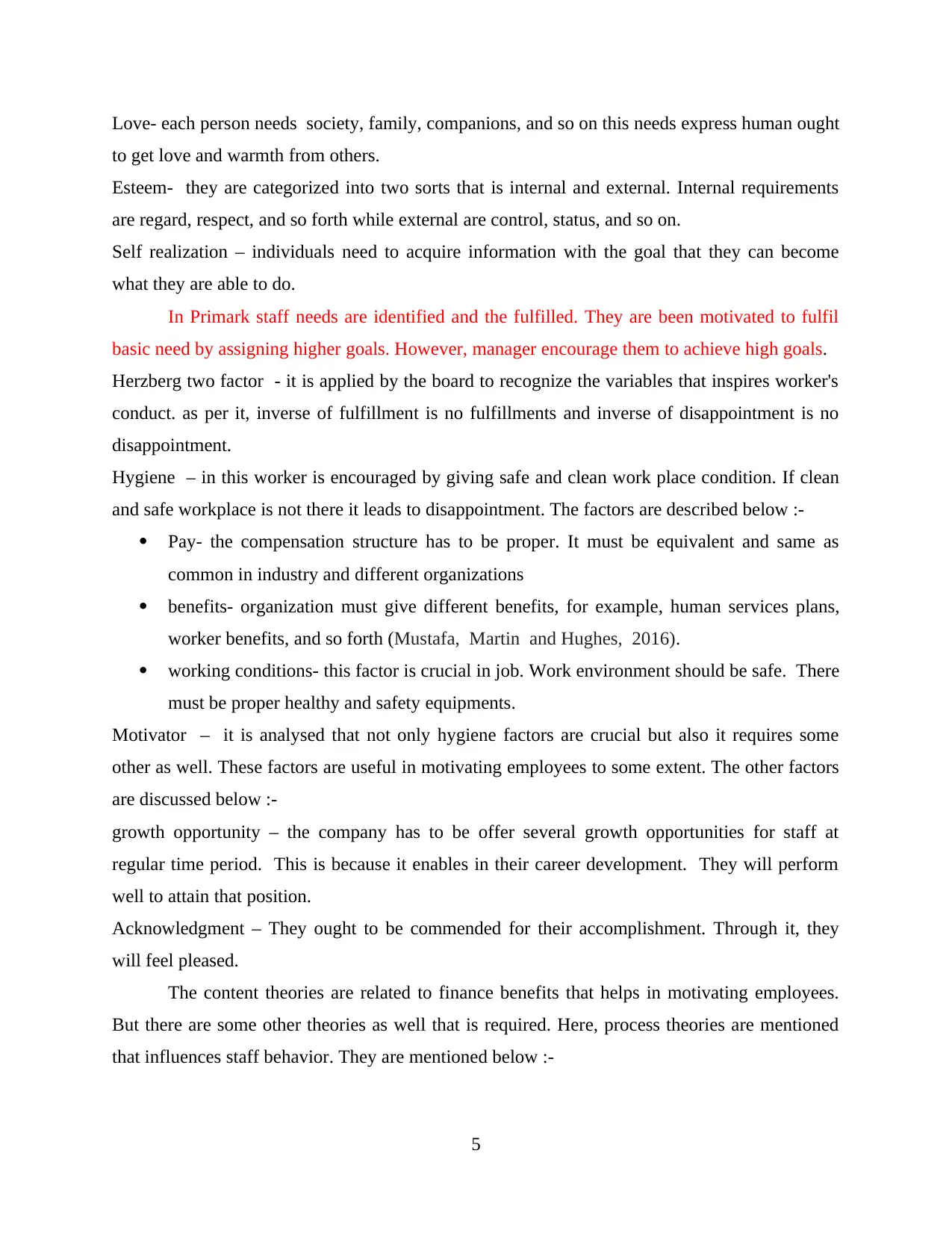
Love- each person needs society, family, companions, and so on this needs express human ought
to get love and warmth from others.
Esteem- they are categorized into two sorts that is internal and external. Internal requirements
are regard, respect, and so forth while external are control, status, and so on.
Self realization – individuals need to acquire information with the goal that they can become
what they are able to do.
In Primark staff needs are identified and the fulfilled. They are been motivated to fulfil
basic need by assigning higher goals. However, manager encourage them to achieve high goals.
Herzberg two factor - it is applied by the board to recognize the variables that inspires worker's
conduct. as per it, inverse of fulfillment is no fulfillments and inverse of disappointment is no
disappointment.
Hygiene – in this worker is encouraged by giving safe and clean work place condition. If clean
and safe workplace is not there it leads to disappointment. The factors are described below :-
Pay- the compensation structure has to be proper. It must be equivalent and same as
common in industry and different organizations
benefits- organization must give different benefits, for example, human services plans,
worker benefits, and so forth (Mustafa, Martin and Hughes, 2016).
working conditions- this factor is crucial in job. Work environment should be safe. There
must be proper healthy and safety equipments.
Motivator – it is analysed that not only hygiene factors are crucial but also it requires some
other as well. These factors are useful in motivating employees to some extent. The other factors
are discussed below :-
growth opportunity – the company has to be offer several growth opportunities for staff at
regular time period. This is because it enables in their career development. They will perform
well to attain that position.
Acknowledgment – They ought to be commended for their accomplishment. Through it, they
will feel pleased.
The content theories are related to finance benefits that helps in motivating employees.
But there are some other theories as well that is required. Here, process theories are mentioned
that influences staff behavior. They are mentioned below :-
5
to get love and warmth from others.
Esteem- they are categorized into two sorts that is internal and external. Internal requirements
are regard, respect, and so forth while external are control, status, and so on.
Self realization – individuals need to acquire information with the goal that they can become
what they are able to do.
In Primark staff needs are identified and the fulfilled. They are been motivated to fulfil
basic need by assigning higher goals. However, manager encourage them to achieve high goals.
Herzberg two factor - it is applied by the board to recognize the variables that inspires worker's
conduct. as per it, inverse of fulfillment is no fulfillments and inverse of disappointment is no
disappointment.
Hygiene – in this worker is encouraged by giving safe and clean work place condition. If clean
and safe workplace is not there it leads to disappointment. The factors are described below :-
Pay- the compensation structure has to be proper. It must be equivalent and same as
common in industry and different organizations
benefits- organization must give different benefits, for example, human services plans,
worker benefits, and so forth (Mustafa, Martin and Hughes, 2016).
working conditions- this factor is crucial in job. Work environment should be safe. There
must be proper healthy and safety equipments.
Motivator – it is analysed that not only hygiene factors are crucial but also it requires some
other as well. These factors are useful in motivating employees to some extent. The other factors
are discussed below :-
growth opportunity – the company has to be offer several growth opportunities for staff at
regular time period. This is because it enables in their career development. They will perform
well to attain that position.
Acknowledgment – They ought to be commended for their accomplishment. Through it, they
will feel pleased.
The content theories are related to finance benefits that helps in motivating employees.
But there are some other theories as well that is required. Here, process theories are mentioned
that influences staff behavior. They are mentioned below :-
5
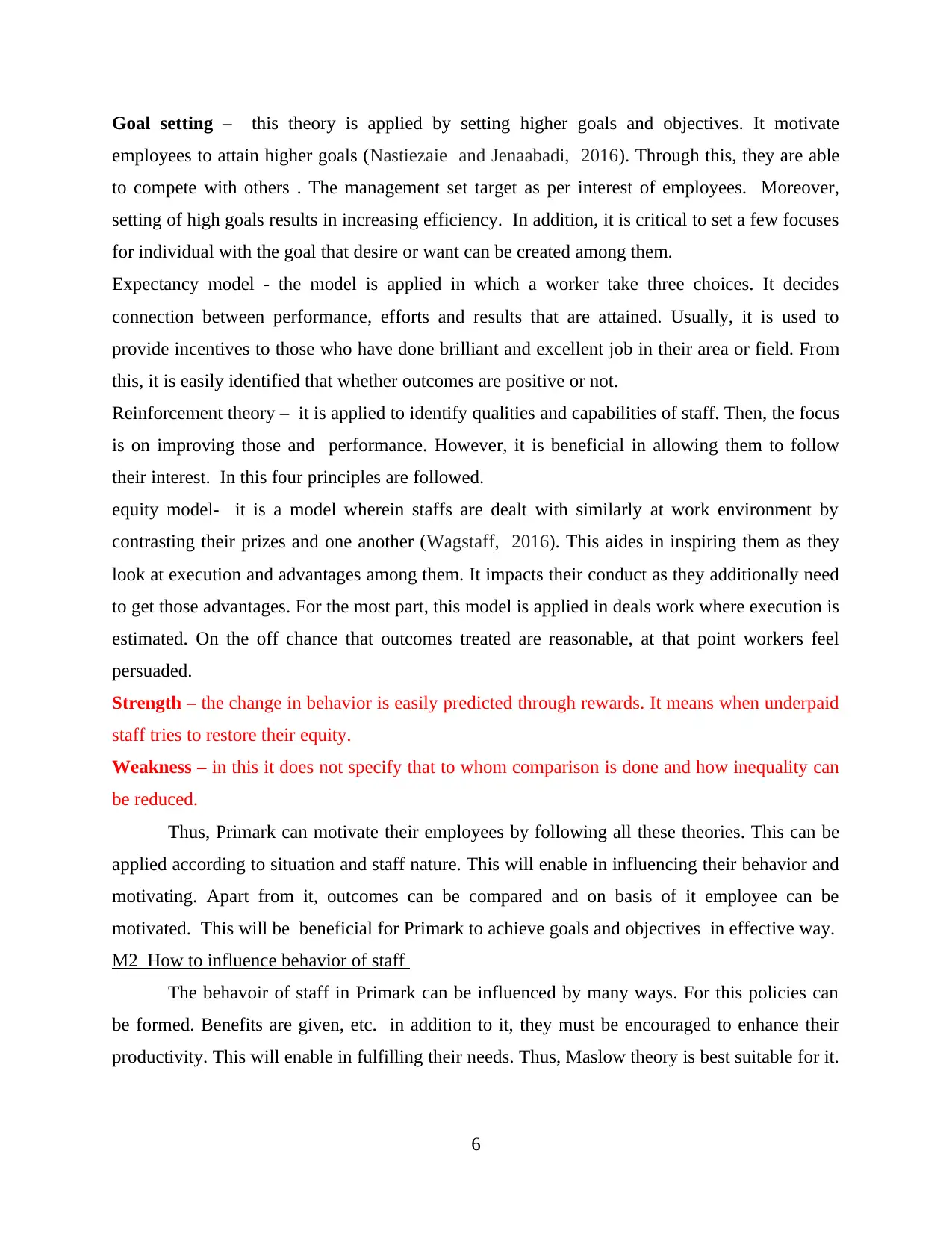
Goal setting – this theory is applied by setting higher goals and objectives. It motivate
employees to attain higher goals (Nastiezaie and Jenaabadi, 2016). Through this, they are able
to compete with others . The management set target as per interest of employees. Moreover,
setting of high goals results in increasing efficiency. In addition, it is critical to set a few focuses
for individual with the goal that desire or want can be created among them.
Expectancy model - the model is applied in which a worker take three choices. It decides
connection between performance, efforts and results that are attained. Usually, it is used to
provide incentives to those who have done brilliant and excellent job in their area or field. From
this, it is easily identified that whether outcomes are positive or not.
Reinforcement theory – it is applied to identify qualities and capabilities of staff. Then, the focus
is on improving those and performance. However, it is beneficial in allowing them to follow
their interest. In this four principles are followed.
equity model- it is a model wherein staffs are dealt with similarly at work environment by
contrasting their prizes and one another (Wagstaff, 2016). This aides in inspiring them as they
look at execution and advantages among them. It impacts their conduct as they additionally need
to get those advantages. For the most part, this model is applied in deals work where execution is
estimated. On the off chance that outcomes treated are reasonable, at that point workers feel
persuaded.
Strength – the change in behavior is easily predicted through rewards. It means when underpaid
staff tries to restore their equity.
Weakness – in this it does not specify that to whom comparison is done and how inequality can
be reduced.
Thus, Primark can motivate their employees by following all these theories. This can be
applied according to situation and staff nature. This will enable in influencing their behavior and
motivating. Apart from it, outcomes can be compared and on basis of it employee can be
motivated. This will be beneficial for Primark to achieve goals and objectives in effective way.
M2 How to influence behavior of staff
The behavoir of staff in Primark can be influenced by many ways. For this policies can
be formed. Benefits are given, etc. in addition to it, they must be encouraged to enhance their
productivity. This will enable in fulfilling their needs. Thus, Maslow theory is best suitable for it.
6
employees to attain higher goals (Nastiezaie and Jenaabadi, 2016). Through this, they are able
to compete with others . The management set target as per interest of employees. Moreover,
setting of high goals results in increasing efficiency. In addition, it is critical to set a few focuses
for individual with the goal that desire or want can be created among them.
Expectancy model - the model is applied in which a worker take three choices. It decides
connection between performance, efforts and results that are attained. Usually, it is used to
provide incentives to those who have done brilliant and excellent job in their area or field. From
this, it is easily identified that whether outcomes are positive or not.
Reinforcement theory – it is applied to identify qualities and capabilities of staff. Then, the focus
is on improving those and performance. However, it is beneficial in allowing them to follow
their interest. In this four principles are followed.
equity model- it is a model wherein staffs are dealt with similarly at work environment by
contrasting their prizes and one another (Wagstaff, 2016). This aides in inspiring them as they
look at execution and advantages among them. It impacts their conduct as they additionally need
to get those advantages. For the most part, this model is applied in deals work where execution is
estimated. On the off chance that outcomes treated are reasonable, at that point workers feel
persuaded.
Strength – the change in behavior is easily predicted through rewards. It means when underpaid
staff tries to restore their equity.
Weakness – in this it does not specify that to whom comparison is done and how inequality can
be reduced.
Thus, Primark can motivate their employees by following all these theories. This can be
applied according to situation and staff nature. This will enable in influencing their behavior and
motivating. Apart from it, outcomes can be compared and on basis of it employee can be
motivated. This will be beneficial for Primark to achieve goals and objectives in effective way.
M2 How to influence behavior of staff
The behavoir of staff in Primark can be influenced by many ways. For this policies can
be formed. Benefits are given, etc. in addition to it, they must be encouraged to enhance their
productivity. This will enable in fulfilling their needs. Thus, Maslow theory is best suitable for it.
6
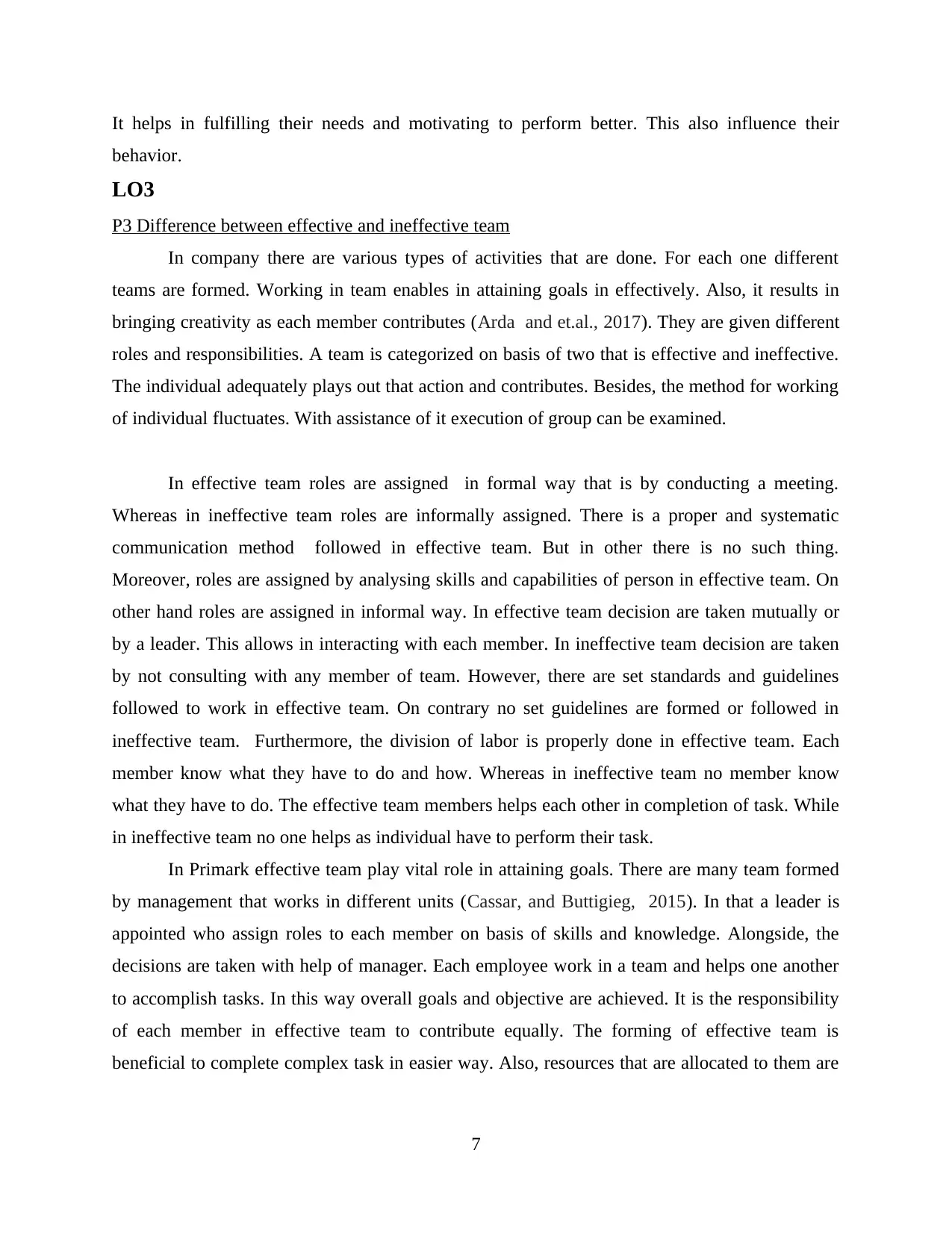
It helps in fulfilling their needs and motivating to perform better. This also influence their
behavior.
LO3
P3 Difference between effective and ineffective team
In company there are various types of activities that are done. For each one different
teams are formed. Working in team enables in attaining goals in effectively. Also, it results in
bringing creativity as each member contributes (Arda and et.al., 2017). They are given different
roles and responsibilities. A team is categorized on basis of two that is effective and ineffective.
The individual adequately plays out that action and contributes. Besides, the method for working
of individual fluctuates. With assistance of it execution of group can be examined.
In effective team roles are assigned in formal way that is by conducting a meeting.
Whereas in ineffective team roles are informally assigned. There is a proper and systematic
communication method followed in effective team. But in other there is no such thing.
Moreover, roles are assigned by analysing skills and capabilities of person in effective team. On
other hand roles are assigned in informal way. In effective team decision are taken mutually or
by a leader. This allows in interacting with each member. In ineffective team decision are taken
by not consulting with any member of team. However, there are set standards and guidelines
followed to work in effective team. On contrary no set guidelines are formed or followed in
ineffective team. Furthermore, the division of labor is properly done in effective team. Each
member know what they have to do and how. Whereas in ineffective team no member know
what they have to do. The effective team members helps each other in completion of task. While
in ineffective team no one helps as individual have to perform their task.
In Primark effective team play vital role in attaining goals. There are many team formed
by management that works in different units (Cassar, and Buttigieg, 2015). In that a leader is
appointed who assign roles to each member on basis of skills and knowledge. Alongside, the
decisions are taken with help of manager. Each employee work in a team and helps one another
to accomplish tasks. In this way overall goals and objective are achieved. It is the responsibility
of each member in effective team to contribute equally. The forming of effective team is
beneficial to complete complex task in easier way. Also, resources that are allocated to them are
7
behavior.
LO3
P3 Difference between effective and ineffective team
In company there are various types of activities that are done. For each one different
teams are formed. Working in team enables in attaining goals in effectively. Also, it results in
bringing creativity as each member contributes (Arda and et.al., 2017). They are given different
roles and responsibilities. A team is categorized on basis of two that is effective and ineffective.
The individual adequately plays out that action and contributes. Besides, the method for working
of individual fluctuates. With assistance of it execution of group can be examined.
In effective team roles are assigned in formal way that is by conducting a meeting.
Whereas in ineffective team roles are informally assigned. There is a proper and systematic
communication method followed in effective team. But in other there is no such thing.
Moreover, roles are assigned by analysing skills and capabilities of person in effective team. On
other hand roles are assigned in informal way. In effective team decision are taken mutually or
by a leader. This allows in interacting with each member. In ineffective team decision are taken
by not consulting with any member of team. However, there are set standards and guidelines
followed to work in effective team. On contrary no set guidelines are formed or followed in
ineffective team. Furthermore, the division of labor is properly done in effective team. Each
member know what they have to do and how. Whereas in ineffective team no member know
what they have to do. The effective team members helps each other in completion of task. While
in ineffective team no one helps as individual have to perform their task.
In Primark effective team play vital role in attaining goals. There are many team formed
by management that works in different units (Cassar, and Buttigieg, 2015). In that a leader is
appointed who assign roles to each member on basis of skills and knowledge. Alongside, the
decisions are taken with help of manager. Each employee work in a team and helps one another
to accomplish tasks. In this way overall goals and objective are achieved. It is the responsibility
of each member in effective team to contribute equally. The forming of effective team is
beneficial to complete complex task in easier way. Also, resources that are allocated to them are
7
Paraphrase This Document
Need a fresh take? Get an instant paraphrase of this document with our AI Paraphraser
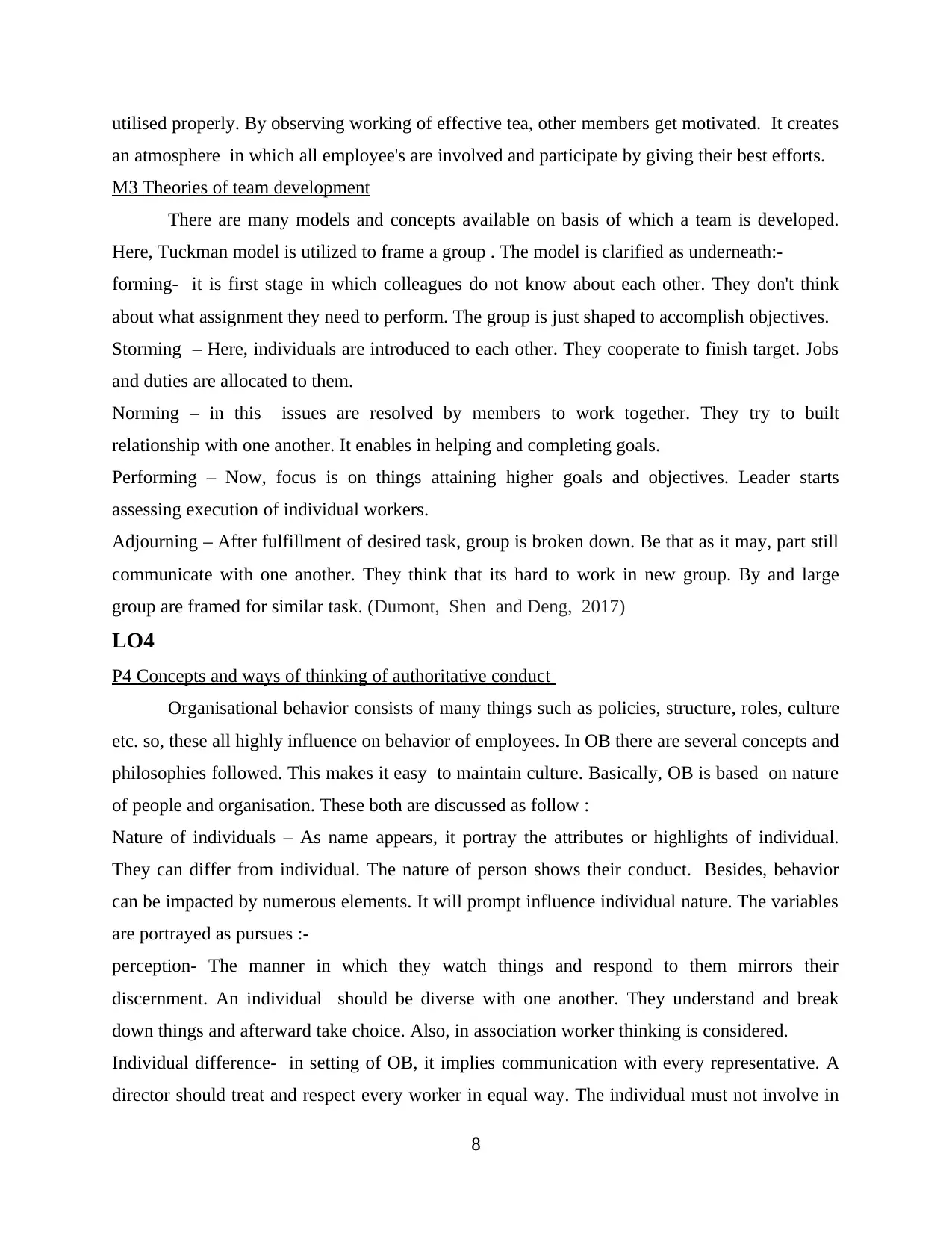
utilised properly. By observing working of effective tea, other members get motivated. It creates
an atmosphere in which all employee's are involved and participate by giving their best efforts.
M3 Theories of team development
There are many models and concepts available on basis of which a team is developed.
Here, Tuckman model is utilized to frame a group . The model is clarified as underneath:-
forming- it is first stage in which colleagues do not know about each other. They don't think
about what assignment they need to perform. The group is just shaped to accomplish objectives.
Storming – Here, individuals are introduced to each other. They cooperate to finish target. Jobs
and duties are allocated to them.
Norming – in this issues are resolved by members to work together. They try to built
relationship with one another. It enables in helping and completing goals.
Performing – Now, focus is on things attaining higher goals and objectives. Leader starts
assessing execution of individual workers.
Adjourning – After fulfillment of desired task, group is broken down. Be that as it may, part still
communicate with one another. They think that its hard to work in new group. By and large
group are framed for similar task. (Dumont, Shen and Deng, 2017)
LO4
P4 Concepts and ways of thinking of authoritative conduct
Organisational behavior consists of many things such as policies, structure, roles, culture
etc. so, these all highly influence on behavior of employees. In OB there are several concepts and
philosophies followed. This makes it easy to maintain culture. Basically, OB is based on nature
of people and organisation. These both are discussed as follow :
Nature of individuals – As name appears, it portray the attributes or highlights of individual.
They can differ from individual. The nature of person shows their conduct. Besides, behavior
can be impacted by numerous elements. It will prompt influence individual nature. The variables
are portrayed as pursues :-
perception- The manner in which they watch things and respond to them mirrors their
discernment. An individual should be diverse with one another. They understand and break
down things and afterward take choice. Also, in association worker thinking is considered.
Individual difference- in setting of OB, it implies communication with every representative. A
director should treat and respect every worker in equal way. The individual must not involve in
8
an atmosphere in which all employee's are involved and participate by giving their best efforts.
M3 Theories of team development
There are many models and concepts available on basis of which a team is developed.
Here, Tuckman model is utilized to frame a group . The model is clarified as underneath:-
forming- it is first stage in which colleagues do not know about each other. They don't think
about what assignment they need to perform. The group is just shaped to accomplish objectives.
Storming – Here, individuals are introduced to each other. They cooperate to finish target. Jobs
and duties are allocated to them.
Norming – in this issues are resolved by members to work together. They try to built
relationship with one another. It enables in helping and completing goals.
Performing – Now, focus is on things attaining higher goals and objectives. Leader starts
assessing execution of individual workers.
Adjourning – After fulfillment of desired task, group is broken down. Be that as it may, part still
communicate with one another. They think that its hard to work in new group. By and large
group are framed for similar task. (Dumont, Shen and Deng, 2017)
LO4
P4 Concepts and ways of thinking of authoritative conduct
Organisational behavior consists of many things such as policies, structure, roles, culture
etc. so, these all highly influence on behavior of employees. In OB there are several concepts and
philosophies followed. This makes it easy to maintain culture. Basically, OB is based on nature
of people and organisation. These both are discussed as follow :
Nature of individuals – As name appears, it portray the attributes or highlights of individual.
They can differ from individual. The nature of person shows their conduct. Besides, behavior
can be impacted by numerous elements. It will prompt influence individual nature. The variables
are portrayed as pursues :-
perception- The manner in which they watch things and respond to them mirrors their
discernment. An individual should be diverse with one another. They understand and break
down things and afterward take choice. Also, in association worker thinking is considered.
Individual difference- in setting of OB, it implies communication with every representative. A
director should treat and respect every worker in equal way. The individual must not involve in
8
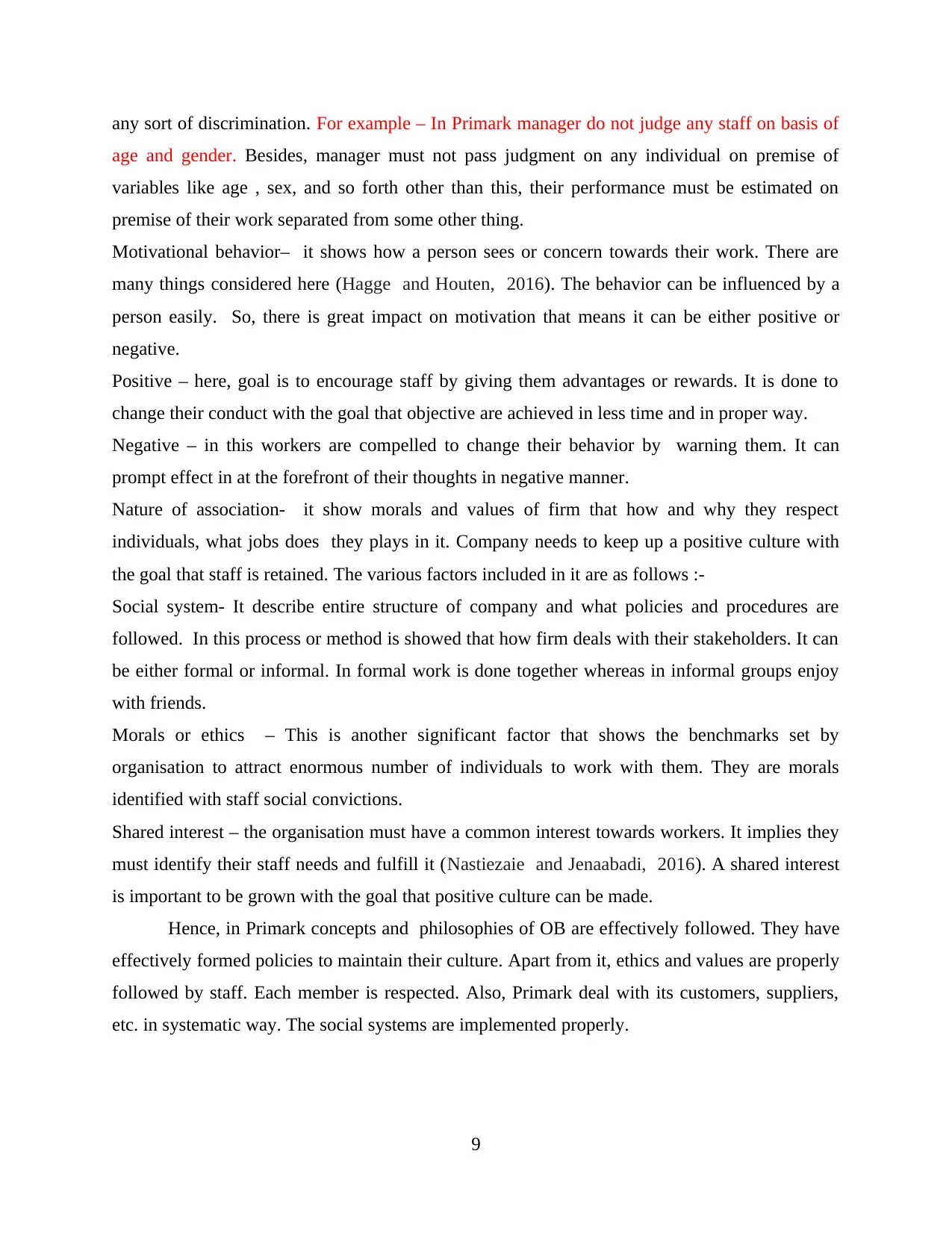
any sort of discrimination. For example – In Primark manager do not judge any staff on basis of
age and gender. Besides, manager must not pass judgment on any individual on premise of
variables like age , sex, and so forth other than this, their performance must be estimated on
premise of their work separated from some other thing.
Motivational behavior– it shows how a person sees or concern towards their work. There are
many things considered here (Hagge and Houten, 2016). The behavior can be influenced by a
person easily. So, there is great impact on motivation that means it can be either positive or
negative.
Positive – here, goal is to encourage staff by giving them advantages or rewards. It is done to
change their conduct with the goal that objective are achieved in less time and in proper way.
Negative – in this workers are compelled to change their behavior by warning them. It can
prompt effect in at the forefront of their thoughts in negative manner.
Nature of association- it show morals and values of firm that how and why they respect
individuals, what jobs does they plays in it. Company needs to keep up a positive culture with
the goal that staff is retained. The various factors included in it are as follows :-
Social system- It describe entire structure of company and what policies and procedures are
followed. In this process or method is showed that how firm deals with their stakeholders. It can
be either formal or informal. In formal work is done together whereas in informal groups enjoy
with friends.
Morals or ethics – This is another significant factor that shows the benchmarks set by
organisation to attract enormous number of individuals to work with them. They are morals
identified with staff social convictions.
Shared interest – the organisation must have a common interest towards workers. It implies they
must identify their staff needs and fulfill it (Nastiezaie and Jenaabadi, 2016). A shared interest
is important to be grown with the goal that positive culture can be made.
Hence, in Primark concepts and philosophies of OB are effectively followed. They have
effectively formed policies to maintain their culture. Apart from it, ethics and values are properly
followed by staff. Each member is respected. Also, Primark deal with its customers, suppliers,
etc. in systematic way. The social systems are implemented properly.
9
age and gender. Besides, manager must not pass judgment on any individual on premise of
variables like age , sex, and so forth other than this, their performance must be estimated on
premise of their work separated from some other thing.
Motivational behavior– it shows how a person sees or concern towards their work. There are
many things considered here (Hagge and Houten, 2016). The behavior can be influenced by a
person easily. So, there is great impact on motivation that means it can be either positive or
negative.
Positive – here, goal is to encourage staff by giving them advantages or rewards. It is done to
change their conduct with the goal that objective are achieved in less time and in proper way.
Negative – in this workers are compelled to change their behavior by warning them. It can
prompt effect in at the forefront of their thoughts in negative manner.
Nature of association- it show morals and values of firm that how and why they respect
individuals, what jobs does they plays in it. Company needs to keep up a positive culture with
the goal that staff is retained. The various factors included in it are as follows :-
Social system- It describe entire structure of company and what policies and procedures are
followed. In this process or method is showed that how firm deals with their stakeholders. It can
be either formal or informal. In formal work is done together whereas in informal groups enjoy
with friends.
Morals or ethics – This is another significant factor that shows the benchmarks set by
organisation to attract enormous number of individuals to work with them. They are morals
identified with staff social convictions.
Shared interest – the organisation must have a common interest towards workers. It implies they
must identify their staff needs and fulfill it (Nastiezaie and Jenaabadi, 2016). A shared interest
is important to be grown with the goal that positive culture can be made.
Hence, in Primark concepts and philosophies of OB are effectively followed. They have
effectively formed policies to maintain their culture. Apart from it, ethics and values are properly
followed by staff. Each member is respected. Also, Primark deal with its customers, suppliers,
etc. in systematic way. The social systems are implemented properly.
9
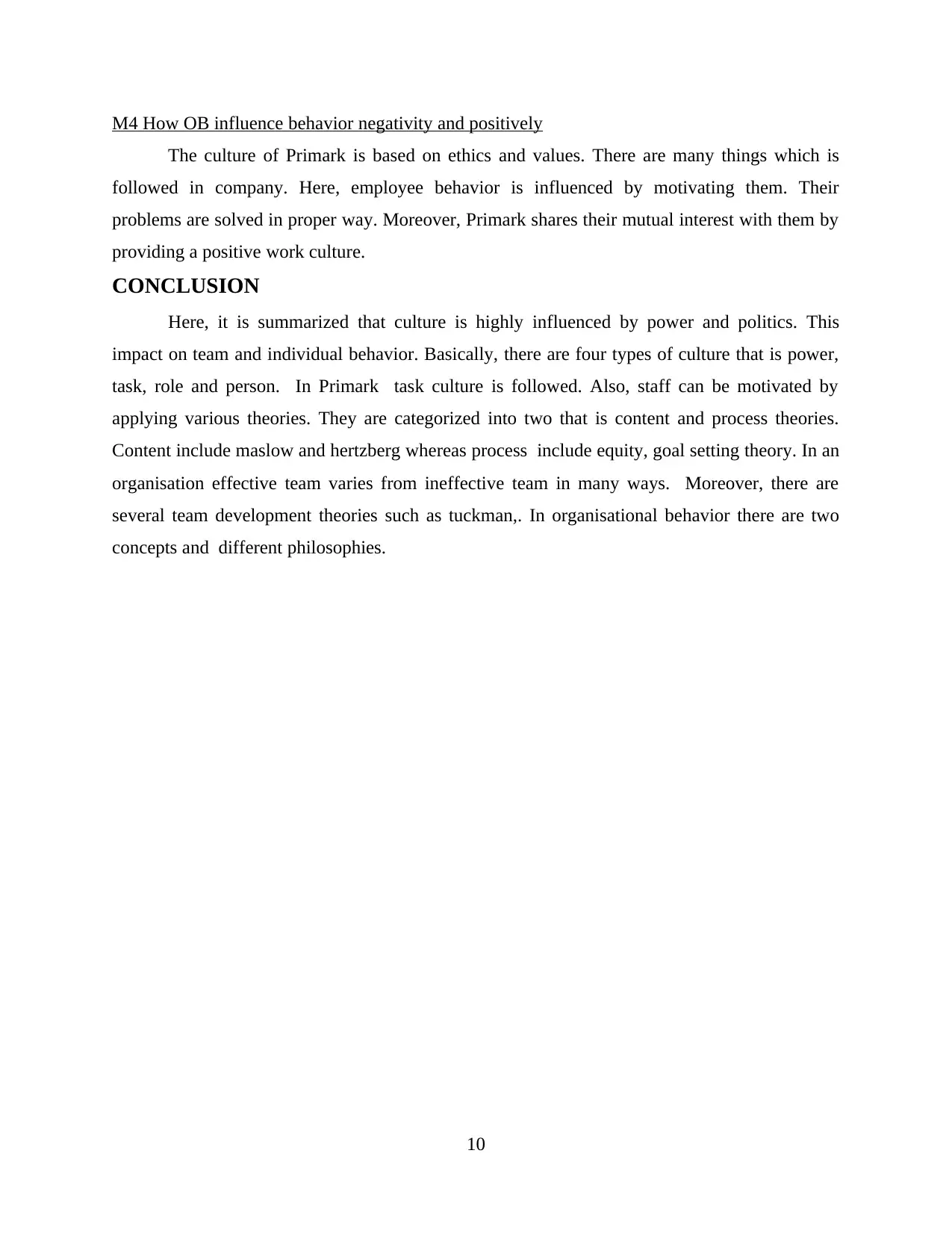
M4 How OB influence behavior negativity and positively
The culture of Primark is based on ethics and values. There are many things which is
followed in company. Here, employee behavior is influenced by motivating them. Their
problems are solved in proper way. Moreover, Primark shares their mutual interest with them by
providing a positive work culture.
CONCLUSION
Here, it is summarized that culture is highly influenced by power and politics. This
impact on team and individual behavior. Basically, there are four types of culture that is power,
task, role and person. In Primark task culture is followed. Also, staff can be motivated by
applying various theories. They are categorized into two that is content and process theories.
Content include maslow and hertzberg whereas process include equity, goal setting theory. In an
organisation effective team varies from ineffective team in many ways. Moreover, there are
several team development theories such as tuckman,. In organisational behavior there are two
concepts and different philosophies.
10
The culture of Primark is based on ethics and values. There are many things which is
followed in company. Here, employee behavior is influenced by motivating them. Their
problems are solved in proper way. Moreover, Primark shares their mutual interest with them by
providing a positive work culture.
CONCLUSION
Here, it is summarized that culture is highly influenced by power and politics. This
impact on team and individual behavior. Basically, there are four types of culture that is power,
task, role and person. In Primark task culture is followed. Also, staff can be motivated by
applying various theories. They are categorized into two that is content and process theories.
Content include maslow and hertzberg whereas process include equity, goal setting theory. In an
organisation effective team varies from ineffective team in many ways. Moreover, there are
several team development theories such as tuckman,. In organisational behavior there are two
concepts and different philosophies.
10
Secure Best Marks with AI Grader
Need help grading? Try our AI Grader for instant feedback on your assignments.
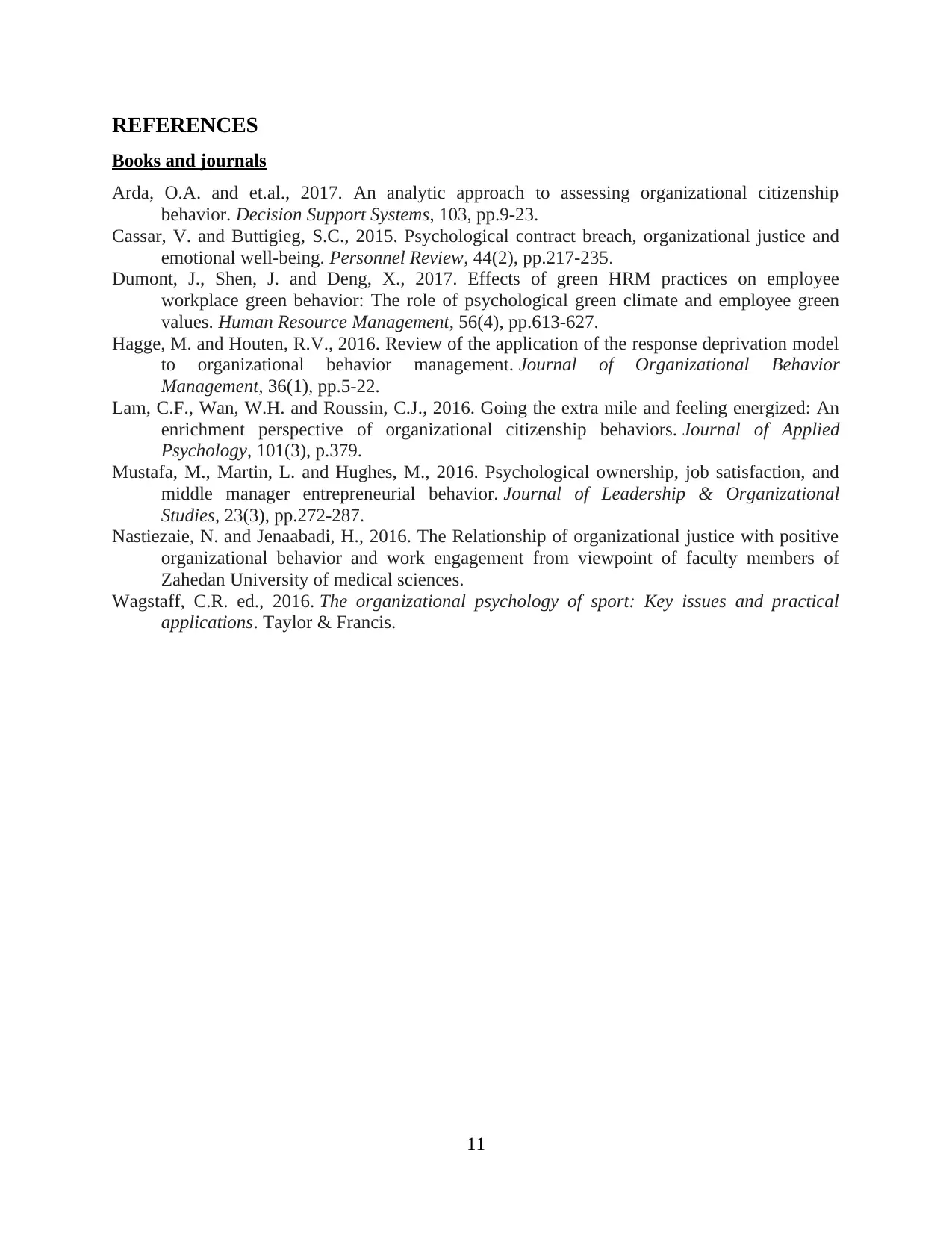
REFERENCES
Books and journals
Arda, O.A. and et.al., 2017. An analytic approach to assessing organizational citizenship
behavior. Decision Support Systems, 103, pp.9-23.
Cassar, V. and Buttigieg, S.C., 2015. Psychological contract breach, organizational justice and
emotional well-being. Personnel Review, 44(2), pp.217-235.
Dumont, J., Shen, J. and Deng, X., 2017. Effects of green HRM practices on employee
workplace green behavior: The role of psychological green climate and employee green
values. Human Resource Management, 56(4), pp.613-627.
Hagge, M. and Houten, R.V., 2016. Review of the application of the response deprivation model
to organizational behavior management. Journal of Organizational Behavior
Management, 36(1), pp.5-22.
Lam, C.F., Wan, W.H. and Roussin, C.J., 2016. Going the extra mile and feeling energized: An
enrichment perspective of organizational citizenship behaviors. Journal of Applied
Psychology, 101(3), p.379.
Mustafa, M., Martin, L. and Hughes, M., 2016. Psychological ownership, job satisfaction, and
middle manager entrepreneurial behavior. Journal of Leadership & Organizational
Studies, 23(3), pp.272-287.
Nastiezaie, N. and Jenaabadi, H., 2016. The Relationship of organizational justice with positive
organizational behavior and work engagement from viewpoint of faculty members of
Zahedan University of medical sciences.
Wagstaff, C.R. ed., 2016. The organizational psychology of sport: Key issues and practical
applications. Taylor & Francis.
11
Books and journals
Arda, O.A. and et.al., 2017. An analytic approach to assessing organizational citizenship
behavior. Decision Support Systems, 103, pp.9-23.
Cassar, V. and Buttigieg, S.C., 2015. Psychological contract breach, organizational justice and
emotional well-being. Personnel Review, 44(2), pp.217-235.
Dumont, J., Shen, J. and Deng, X., 2017. Effects of green HRM practices on employee
workplace green behavior: The role of psychological green climate and employee green
values. Human Resource Management, 56(4), pp.613-627.
Hagge, M. and Houten, R.V., 2016. Review of the application of the response deprivation model
to organizational behavior management. Journal of Organizational Behavior
Management, 36(1), pp.5-22.
Lam, C.F., Wan, W.H. and Roussin, C.J., 2016. Going the extra mile and feeling energized: An
enrichment perspective of organizational citizenship behaviors. Journal of Applied
Psychology, 101(3), p.379.
Mustafa, M., Martin, L. and Hughes, M., 2016. Psychological ownership, job satisfaction, and
middle manager entrepreneurial behavior. Journal of Leadership & Organizational
Studies, 23(3), pp.272-287.
Nastiezaie, N. and Jenaabadi, H., 2016. The Relationship of organizational justice with positive
organizational behavior and work engagement from viewpoint of faculty members of
Zahedan University of medical sciences.
Wagstaff, C.R. ed., 2016. The organizational psychology of sport: Key issues and practical
applications. Taylor & Francis.
11
1 out of 11
Related Documents
Your All-in-One AI-Powered Toolkit for Academic Success.
+13062052269
info@desklib.com
Available 24*7 on WhatsApp / Email
![[object Object]](/_next/static/media/star-bottom.7253800d.svg)
Unlock your academic potential
© 2024 | Zucol Services PVT LTD | All rights reserved.





